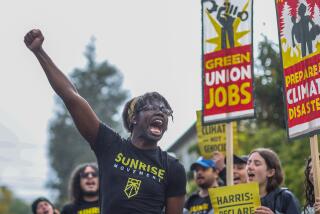Back from the underground
Was ever a political group so woefully mislabeled as the Weather Underground? Named after the Bob Dylan lyric that posited that “you don’t need a weatherman to know which way the wind blows,” these 1960s and ‘70s radicals believed that this country was a New York minute away from “overthrowing the capitalist system and putting in something more humane.” A fatal misjudgment of the winds of change.
Yet these committed radicals, hunted by the FBI for a series of bombings of government buildings in the 1970s, were hardly misguided bumpkins or insensitive hooligans. They were some of the best and brightest of their generation, highly educated and privileged young people, and the things they cared deeply about, like the war in Vietnam and racial inequality in this country, were worth their concern. As David Gilbert puts it, “Was I fighting for a just cause? Was there a need to do something? Yes, there was.”
The story of how people so right could be so wrong, of how intelligent individuals got so tragically trapped on barren paths that Gilbert, for one, is currently serving a 75-year prison sentence in Attica for armed robbery, is the subject of a thoughtful, incisive documentary simply called “The Weather Underground,” a compelling piece of work that turns out to have unexpected relevance to the current world situation.
International terrorism was not the issue it is today when directors Sam Green and Bill Siegel began this film five years ago. But when Underground member Brian Flanagan says, “We wanted to deliver the most horrific hit the United States government ever received on its own soil,” it’s hard not to hear echoes of Al Qaeda thinking. Ditto when Flanagan adds, “If you think that you have the moral high ground, that’s a very dangerous position and you can do some really dreadful things.”
Sympathetic but evenhanded, “The Weather Underground” admires the idealism of its subjects. It tolerantly forgives their continued infatuation with the romantic dream of revolution but is not blind to how off the tracks everything went, how accurate it was to describe the movement, in one observer’s words, as “like a children’s crusade gone mad.”
“The Weather Underground” benefits from the considerable research and work of its directors. The film intercuts clips of the Weather folk in their cocky, confrontational prime with contemporary interviews with Bernardine Dohrn, Bill Ayers and half a dozen other veterans, all thoughtful, articulate, yet noticeably chastened by the weight of their experience.
This gives the project an unexpected air of sadness, a sense of regret that so much thought and energy and intelligence should have ended up accomplishing so little. “When I tell my students that I helped found an organization whose goal was the violent overthrow of the government of the United States,” says Mark Rudd, now a professor at a junior college in New Mexico, “they look at me like I’m from another planet.”
It all started with the war in Vietnam, a conflict whose horrors deeply affected leftist students. “Our country was murdering millions of people, and that knowledge was more than we could handle,” says Rudd, with Ayers adding, “Opposing the war became something that was urgent and imperative. We had to do what we had to do to stop the war.”
Determined to build a revolutionary army and under the delusion that working-class white youth was just itching to revolt, the Weather faction took over Students for a Democratic Society, the mainstream left student organization, a move that still rankles former SDS leader Todd Gitlin, who says, “They ran away with the student left.”
Naive even for radicals, believers that smashing sexual monogamy would somehow hasten world revolution, the Weather Underground did not let logic cloud their resolve. They came to believe that a quiescent public ignorant of their government’s abusive policies was a legitimate target for attack. Fumes a still furious Gitlin, “They were ready to be mass murderers, the same as Hitler and Mao and their grand projects for the reform of all humanity. In the face of that, ordinary life was dispensable.”
That attitude changed when a bomb accidentally went off in New York’s Greenwich Village, killing three Underground members who were planning an attack that would have harmed civilians. After that, though the bombings continued, the film claims the group’s attitude toward loss of life changed and successful attempts were made to avoid casualties.
But though the Weathermen thought they were sending a message to America with their careful selection of targets, hardly anyone was listening. After the Vietnam War ended in 1975, the group lost a lot of its reason for being, and, as Rudd says, “Organizations turn on themselves and kill each other when they’re irrelevant.”
Because the FBI broke laws to gain information against them, many of the Weather Underground members did not serve jail time when they gave themselves up, but that didn’t absolve them of personal soul-searching. Rudd, for one, says he still has “mixed feelings of guilt and shame” when he thinks about American involvement in Vietnam. “I still don’t know,” he says, “what to do with that knowledge.”
*
‘The Weather Underground’
MPAA rating: Unrated
Times guidelines: Adult subject matter
An Upstate Films production, in association with the Free History Project, released by Shadow Distribution. Directors Sam Green, Bill Siegel. Producers Sam Green, Bill Siegel, Carrie Lozano, Marc Smolowitz. Executive producers Christian Ettinger, Mary Harron, Sue Ellen McCann. Cinematographers Andrew Black, Federico Salsano. Editors Sam Green, Dawn Logsdon. Music Dave Cerf, Amy Domingues. Running time: 1 hour, 32 minutes.
Exclusively at the Nuart, 11272 Santa Monica Blvd., West Los Angeles, (310) 478-6379. Directors Bill Siegel and Sam Green will attend the 7:30 and 9:50 p.m. screenings today and Saturday.
More to Read
Only good movies
Get the Indie Focus newsletter, Mark Olsen's weekly guide to the world of cinema.
You may occasionally receive promotional content from the Los Angeles Times.








